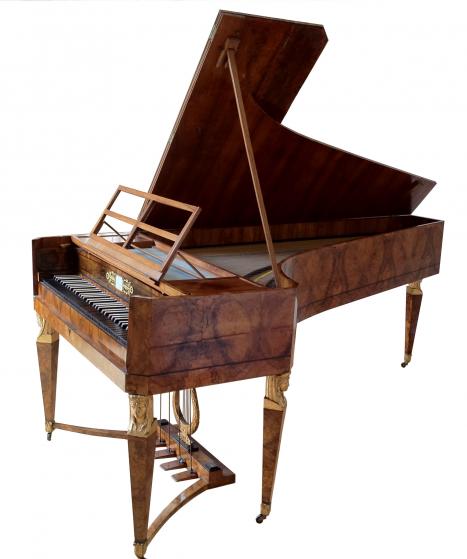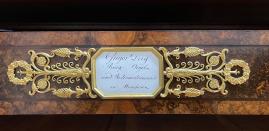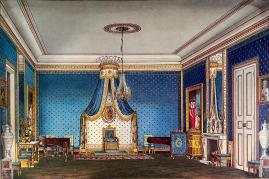grand piano gregor Deiß
munich 1815
Grand piano in Empire style
Mechanism: Viennese action
Range: 6 octaves, 73 keys(F1-f4)
Levers, Pedals: 4 Pedals (from left to right): Bassoon, una corda, dampers, moderator.
Signature:
"Gregor Deiß // Bürg: Orgel- // und Instrumentenmacher // in München"
Dimensions:
LxBxH: 2200 x 1162 x 900 mm


Sound example Grand Piano by Gregor Deiss
The instrument in question is a stylish grand with a keyboard covered in ebony and a body veneered with expressive root wood from walnut and alder. The legs, also veneered with root wood, feature carved and gilded female heads (caryatids) in the Empire style, and at the bottom, there are horn wheels. The music stand consists of a double, height-adjustable frame construction and can be adjusted in its angle and height. The side supports can be pulled out for candles. The four wooden pedals are suspended in an elaborately carved and gilded lyre with griffin heads, and the suspension wires are made of iron wrapped in gilded copper.
The representative and costly furnishings suggest that it was made for a customer from an upper social class, which is known to have been part of Gregor Deiß's clientele. To this day, there is one upright piano from his workshop in both Hohenschwangau Castle and the Munich Residence. A contemporary illustration from 1820 indicates that in the Munich Residence, in the throne room of Queen Caroline, there were two grand pianos present (although Deiß was not a court supplier, but merely a "bourgeois" piano maker). These display a design that is very similar to the instrument in our collection, but not completely identical.

Gregor Deiß (probably around 1764 - 1849) was born in Hagenau in Alsace and initially learned the trade of a carpenter.
After a ten-year period as a journeyman, he arrived in Munich in 1796 and found a position with the organ builder Andreas Grünerdt. Here, he familiarized himself with instrument making and assisted his employer's widow, Monika Grünerdt, after the latter's death in 1798. After nearly a year of disputes with the carpenter's guild and the municipal authorities, they were finally able to marry in 1799. By this marriage, Gregor Deiß acquired Munich citizenship and the right to work as an organ and piano builder under the Grünerdt name.
In addition to Gregor Deiß, Louis Dulcken (court piano builder since 1785) and the two civic organ and piano builders Franz Frosch and Ferdinand Sailer were also active in Munich. Despite a challenging economic environment due to political upheavals and foreign competition in the competitive piano market, Gregor Deiß and his wife managed to acquire realties in 1810 and in the following years, indicating a successful business operation. Deiß not only built and repaired organs in the Munich area but also produced a wide range of pianos. According to the Kunst- und Gewerbeblatt of 1821, these were:
"Upright grand pianos with 6 1/2 octaves, white ivory keyboard, five variations: forte, piano, Bassoon, una corda shift, and Turkish music, with a case made of very beautiful maple veneer...Grand pianos with the same keyboard and variations as above, the case made of cherry wood...Forte piano, very finely crafted, the case made of cherry wood...Square pianos with 6 octaves, 4 variations, white keyboard, and case made of cherry wood in mahogany style (p. 341)."
Contemporaries of Gregor Deiß praised his instruments for their "durability of construction, care and elegance in form and execution, strength, uniformity and softness of tone, arrangement and precision of the various modifications, and above all, ease of use."
Further information: Josef Focht und Silke Berdux: Der Münchner Klavierbauer Gregor Deiß. Ein Hammerflügel um 1815, Greifenberg 1995



